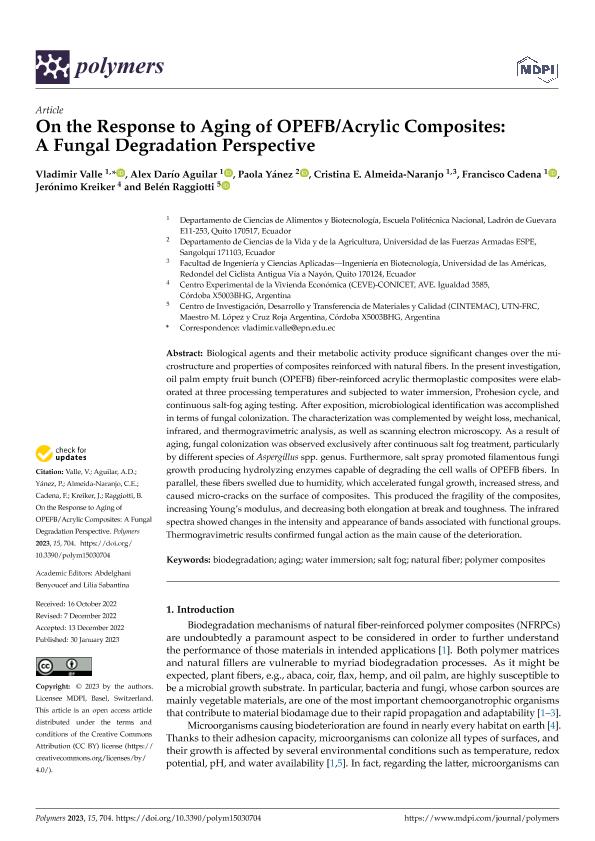Artículo
On the Response to Aging of OPEFB/Acrylic Composites: A Fungal Degradation Perspective
Valle, Vladimir; Aguilar, Alex Darío; Yánez, Paola; Almeida Naranjo, Cristina E.; Cadena, Francisco; Kreiker, Jeronimo Rafael ; Raggiotti, Barbara Belen
; Raggiotti, Barbara Belen
 ; Raggiotti, Barbara Belen
; Raggiotti, Barbara Belen
Fecha de publicación:
02/2023
Editorial:
Multidisciplinary Digital Publishing Institute
Revista:
Polymers
e-ISSN:
2073-4360
Idioma:
Inglés
Tipo de recurso:
Artículo publicado
Clasificación temática:
Resumen
Biological agents and their metabolic activity produce significant changes over the microstructure and properties of composites reinforced with natural fibers. In the present investigation, oil palm empty fruit bunch (OPEFB) fiber-reinforced acrylic thermoplastic composites were elaborated at three processing temperatures and subjected to water immersion, Prohesion cycle, and continuous salt-fog aging testing. After exposition, microbiological identification was accomplished in terms of fungal colonization. The characterization was complemented by weight loss, mechanical, infrared, and thermogravimetric analysis, as well as scanning electron microscopy. As a result of aging, fungal colonization was observed exclusively after continuous salt fog treatment, particularly by different species of Aspergillus spp. genus. Furthermore, salt spray promoted filamentous fungi growth producing hydrolyzing enzymes capable of degrading the cell walls of OPEFB fibers. In parallel, these fibers swelled due to humidity, which accelerated fungal growth, increased stress, and caused micro-cracks on the surface of composites. This produced the fragility of the composites, increasing Young’s modulus, and decreasing both elongation at break and toughness. The infrared spectra showed changes in the intensity and appearance of bands associated with functional groups. Thermogravimetric results confirmed fungal action as the main cause of the deterioration.
Palabras clave:
AGING
,
BIODEGRADATION
,
NATURAL FIBER
,
POLYMER COMPOSITES
,
SALT FOG
,
WATER IMMERSION
Archivos asociados
Licencia
Identificadores
Colecciones
Articulos(CEVE)
Articulos de CENTRO EXPERIMENTAL DE LA VIVIENDA ECONOMICA(I)
Articulos de CENTRO EXPERIMENTAL DE LA VIVIENDA ECONOMICA(I)
Citación
Valle, Vladimir; Aguilar, Alex Darío; Yánez, Paola; Almeida Naranjo, Cristina E.; Cadena, Francisco; et al.; On the Response to Aging of OPEFB/Acrylic Composites: A Fungal Degradation Perspective; Multidisciplinary Digital Publishing Institute; Polymers; 15; 3; 2-2023; 1-16
Compartir
Altmétricas



